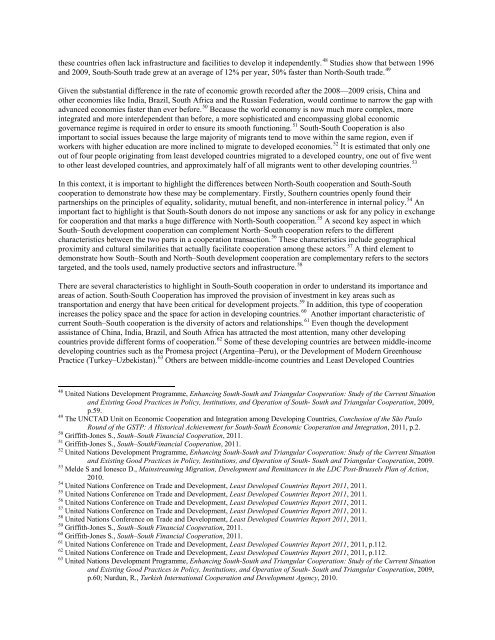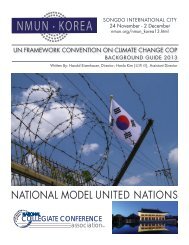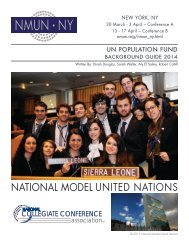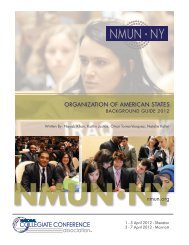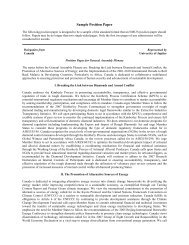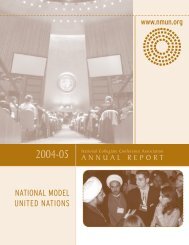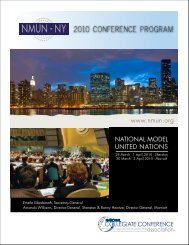UNCTAD Background Guide - National Model United Nations
UNCTAD Background Guide - National Model United Nations
UNCTAD Background Guide - National Model United Nations
Create successful ePaper yourself
Turn your PDF publications into a flip-book with our unique Google optimized e-Paper software.
these countries often lack infrastructure and facilities to develop it independently. 48 Studies show that between 1996<br />
and 2009, South-South trade grew at an average of 12% per year, 50% faster than North-South trade. 49<br />
Given the substantial difference in the rate of economic growth recorded after the 2008—2009 crisis, China and<br />
other economies like India, Brazil, South Africa and the Russian Federation, would continue to narrow the gap with<br />
advanced economies faster than ever before. 50 Because the world economy is now much more complex, more<br />
integrated and more interdependent than before, a more sophisticated and encompassing global economic<br />
governance regime is required in order to ensure its smooth functioning. 51 South-South Cooperation is also<br />
important to social issues because the large majority of migrants tend to move within the same region, even if<br />
workers with higher education are more inclined to migrate to developed economies. 52 It is estimated that only one<br />
out of four people originating from least developed countries migrated to a developed country, one out of five went<br />
to other least developed countries, and approximately half of all migrants went to other developing countries. 53<br />
In this context, it is important to highlight the differences between North-South cooperation and South-South<br />
cooperation to demonstrate how these may be complementary. Firstly, Southern countries openly found their<br />
partnerships on the principles of equality, solidarity, mutual benefit, and non-interference in internal policy. 54 An<br />
important fact to highlight is that South-South donors do not impose any sanctions or ask for any policy in exchange<br />
for cooperation and that marks a huge difference with North-South cooperation. 55 A second key aspect in which<br />
South–South development cooperation can complement North–South cooperation refers to the different<br />
characteristics between the two parts in a cooperation transaction. 56 These characteristics include geographical<br />
proximity and cultural similarities that actually facilitate cooperation among these actors. 57 A third element to<br />
demonstrate how South–South and North–South development cooperation are complementary refers to the sectors<br />
targeted, and the tools used, namely productive sectors and infrastructure. 58<br />
There are several characteristics to highlight in South-South cooperation in order to understand its importance and<br />
areas of action. South-South Cooperation has improved the provision of investment in key areas such as<br />
transportation and energy that have been critical for development projects. 59 In addition, this type of cooperation<br />
increases the policy space and the space for action in developing countries. 60 Another important characteristic of<br />
current South–South cooperation is the diversity of actors and relationships. 61 Even though the development<br />
assistance of China, India, Brazil, and South Africa has attracted the most attention, many other developing<br />
countries provide different forms of cooperation. 62 Some of these developing countries are between middle-income<br />
developing countries such as the Promesa project (Argentina–Peru), or the Development of Modern Greenhouse<br />
Practice (Turkey–Uzbekistan). 63 Others are between middle-income countries and Least Developed Countries<br />
48 <strong>United</strong> <strong>Nations</strong> Development Programme, Enhancing South-South and Triangular Cooperation: Study of the Current Situation<br />
and Existing Good Practices in Policy, Institutions, and Operation of South- South and Triangular Cooperation, 2009,<br />
p.59.<br />
49 The <strong>UNCTAD</strong> Unit on Economic Cooperation and Integration among Developing Countries, Conclusion of the São Paulo<br />
Round of the GSTP: A Historical Achievement for South-South Economic Cooperation and Integration, 2011, p.2.<br />
50 Griffith-Jones S., South–South Financial Cooperation, 2011.<br />
51 Griffith-Jones S., South–SouthFinancial Cooperation, 2011.<br />
52 <strong>United</strong> <strong>Nations</strong> Development Programme, Enhancing South-South and Triangular Cooperation: Study of the Current Situation<br />
and Existing Good Practices in Policy, Institutions, and Operation of South- South and Triangular Cooperation, 2009.<br />
53 Melde S and Ionesco D., Mainstreaming Migration, Development and Remittances in the LDC Post-Brussels Plan of Action,<br />
2010.<br />
54 <strong>United</strong> <strong>Nations</strong> Conference on Trade and Development, Least Developed Countries Report 2011, 2011.<br />
55 <strong>United</strong> <strong>Nations</strong> Conference on Trade and Development, Least Developed Countries Report 2011, 2011.<br />
56 <strong>United</strong> <strong>Nations</strong> Conference on Trade and Development, Least Developed Countries Report 2011, 2011.<br />
57 <strong>United</strong> <strong>Nations</strong> Conference on Trade and Development, Least Developed Countries Report 2011, 2011.<br />
58 <strong>United</strong> <strong>Nations</strong> Conference on Trade and Development, Least Developed Countries Report 2011, 2011.<br />
59 Griffith-Jones S., South–South Financial Cooperation, 2011.<br />
60 Griffith-Jones S., South–South Financial Cooperation, 2011.<br />
61 <strong>United</strong> <strong>Nations</strong> Conference on Trade and Development, Least Developed Countries Report 2011, 2011, p.112.<br />
62 <strong>United</strong> <strong>Nations</strong> Conference on Trade and Development, Least Developed Countries Report 2011, 2011, p.112.<br />
63 <strong>United</strong> <strong>Nations</strong> Development Programme, Enhancing South-South and Triangular Cooperation: Study of the Current Situation<br />
and Existing Good Practices in Policy, Institutions, and Operation of South- South and Triangular Cooperation, 2009,<br />
p.60; Nurdun, R., Turkish International Cooperation and Development Agency, 2010.


